Medium Format
Lenses with the Pentacon Six Mount
A comparative test
by TRA
Tilt lenses
And there’s more! – How about
tilting the lens?
Theodor Scheimpflug was (according to http://en.wikipedia.org/wiki/Scheimpflug_principle)
an Austrian who in 1904 patented an idea describing how to gain
maximum focus when swinging or tilting the lens panel in the
cameras of the time. If you stand facing a flat object, such
as a building, hold the camera with the back exactly parallel to
the building,and focus correctly, the whole building will be in
sharp focus even at maximum aperture (if the lens is good!).
However, in most cases, the picture will not be very
interesting. But if you stand on the pavement (US readers:
sidewalk) looking down the street with the building on your right
side, but you then rotate through 45°, you are likely to get a
more interesting view of the building within its
environment. However, at maximum aperture only a small part
of the building will be sharply in focus, with the bits that are
closer to or father from that point going increasingly out of
focus.
Enter Herr Scheimpflug.
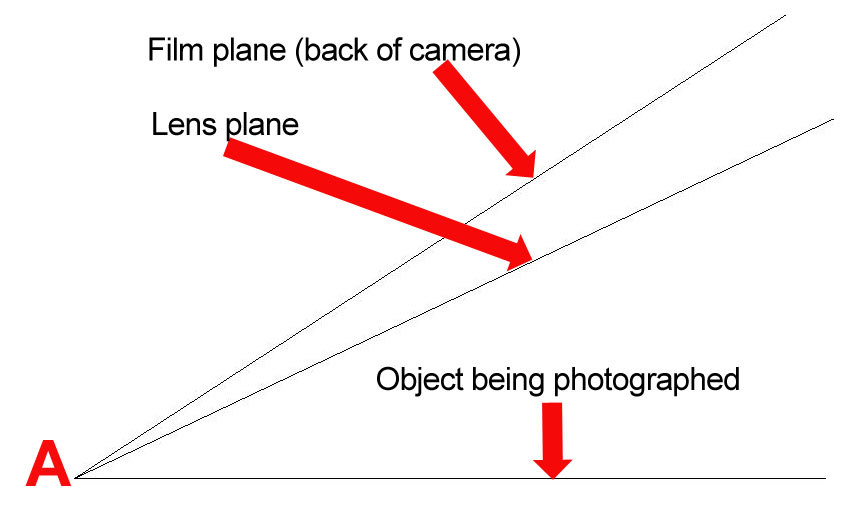 |
|
Imagine that this is an aerial view looking down on the
situation that we just described.
The line at the bottom is the front of the building that
you want to photograph.
You are standing holding the camera at the position and
angle shown by the arrow “Film plane (back of
camera)”. If for some reason you need to use a large
aperture, you have no chance of getting most of the
building in focus.
However, if you could swing the lens sideways (rotating it
through its vertical axis), the focus would improve.
Imagine
- a straight line running left and right from the
film back (the top line in this diagram)
- another straight line running through the front
plate of the camera that holds the lens
- a third straight line running along the front of
the building.
If these three imaginary lines meet (point “A”), the image
will be totally sharp across the whole frame.
Thank you, Herr Scheimpflug.
|
However, when he took out his patent over 100 years ago,
achieving this was easy with many cameras: the film (or usually
glass plate) was held at the back of the camera in a wooden back,
the lens was held in a flat wooden plate at the front of the
camera, and between the two there were flexible leather
bellows. Just design a way of swinging the front, and the
focussing problem is solved. Voilŕ, as the French say!
In fact, cameras were designed in which you could swing (from side
to side) tilt (backwards and forwards) and shift (raise, lower, or
move sideways) both the front and rear standards. Moving the
front changes the focus, moving the back changes the shape of the
image, to correct (or even cause!) distortions.
You can still get such camera. I made one, using a kit
manufactured by Bender in the USA.
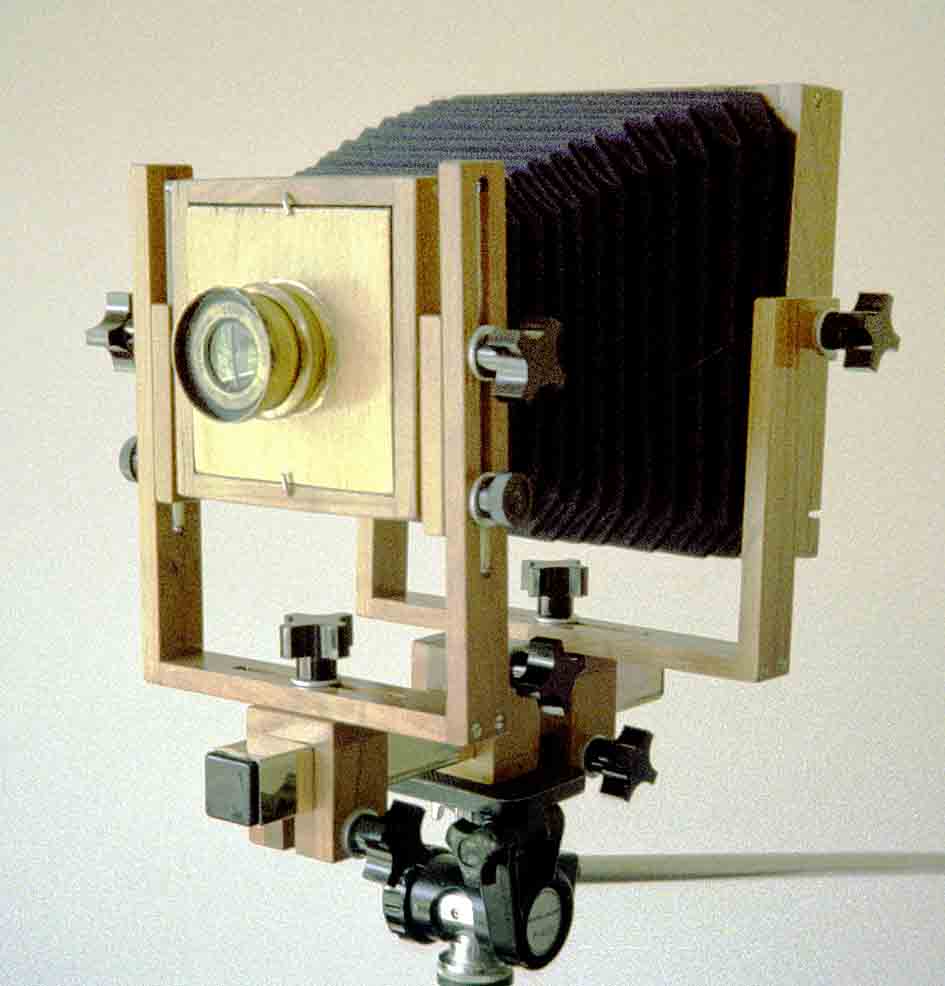 [C104-29A] My Bender 5 × 4 camera
[C104-29A] My Bender 5 × 4 camera
|
|
The results are superb, but the camera is very large and
awkward to carry and use, and setting up a shot is slow.
Bender’s website is here.
(Note that the camera kit is supplied without
any lenses.)
|
|
 [C104-32A] Both front and rear standards
tilt!
[C104-32A] Both front and rear standards
tilt!
|
So, if you want to use a regular Medium Format SLR film camera,
what do you do?
You can obtain most of the advantages of a “view camera” by using
“technical bellows” on the Pentacon Six. For details,
see here.
Or you can use a tilt-shift lens made by Hartblei!
(possibly still available from Michael Fourman at Kiev Camera)
Hartblei use the 45mm Mir 26 optical components in three
different mounts:
- in the shift only mount described on the previous page.
This enables shift in any direction.
- in a tilt/shift mount with shift in any direction but the
possibility to tilt the lens downwards only
- in a tilt/shift mount with full and independent rotation of
shift and tilt. They call this their TS – PC [Tilt-Shift –
Perspective Control] Super-Rotator. It has two independent
rings that enable the user to rotate either the
direction of shift or the direction of tilt or both!
Use the shift to correct distortion, and the tilt to increase
(or even to reduce!) depth of field.
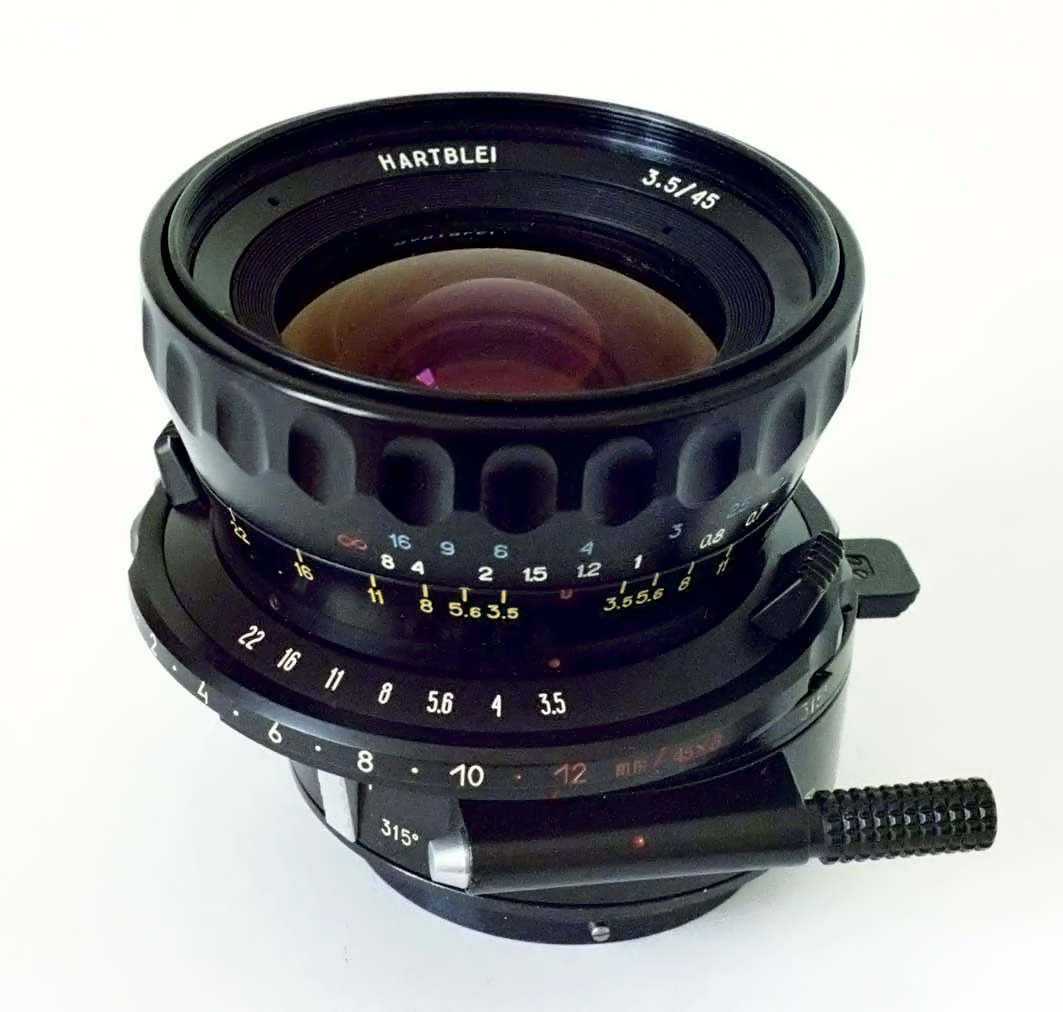
The Hartblei Super-Rotator 45mm Tilt/Shift lens
And here it is on a Pentacon Six:
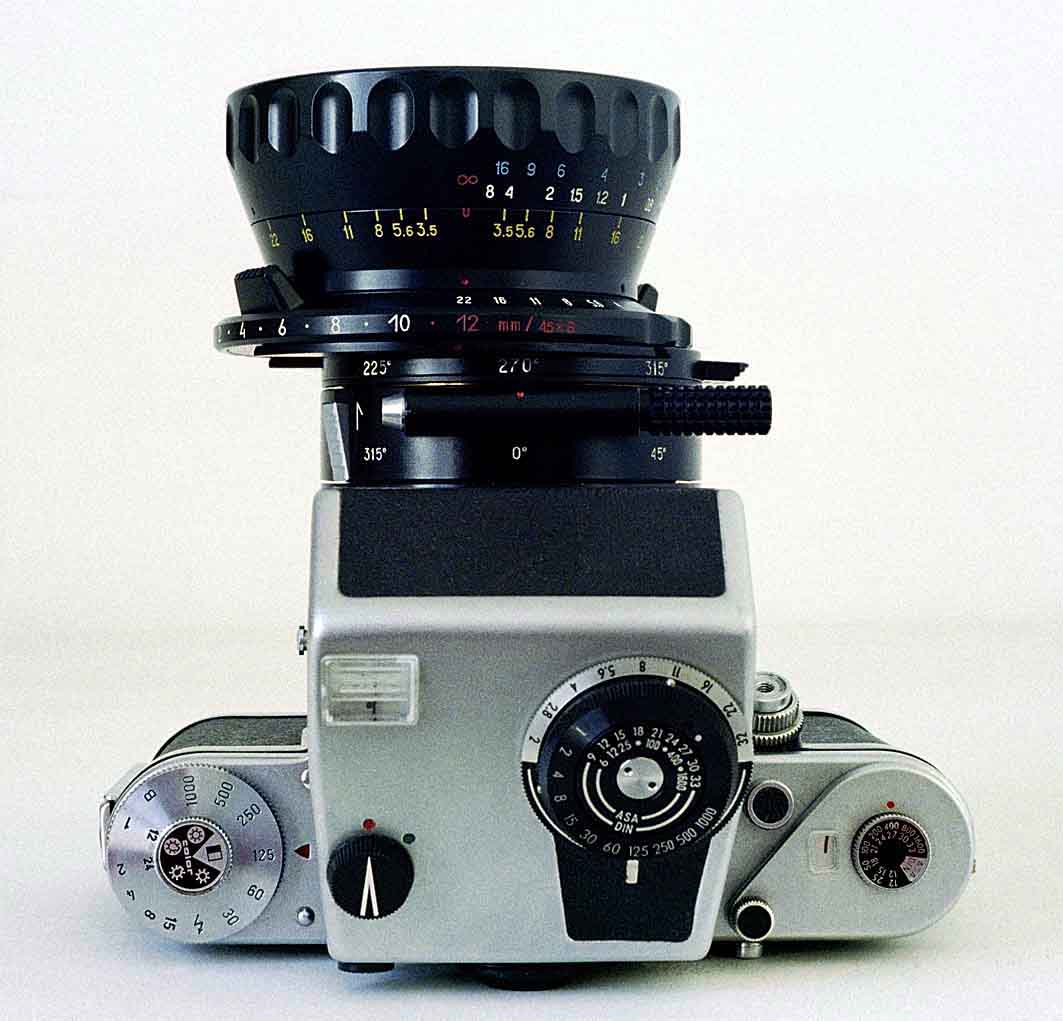 fully shifted
fully shifted
|
|
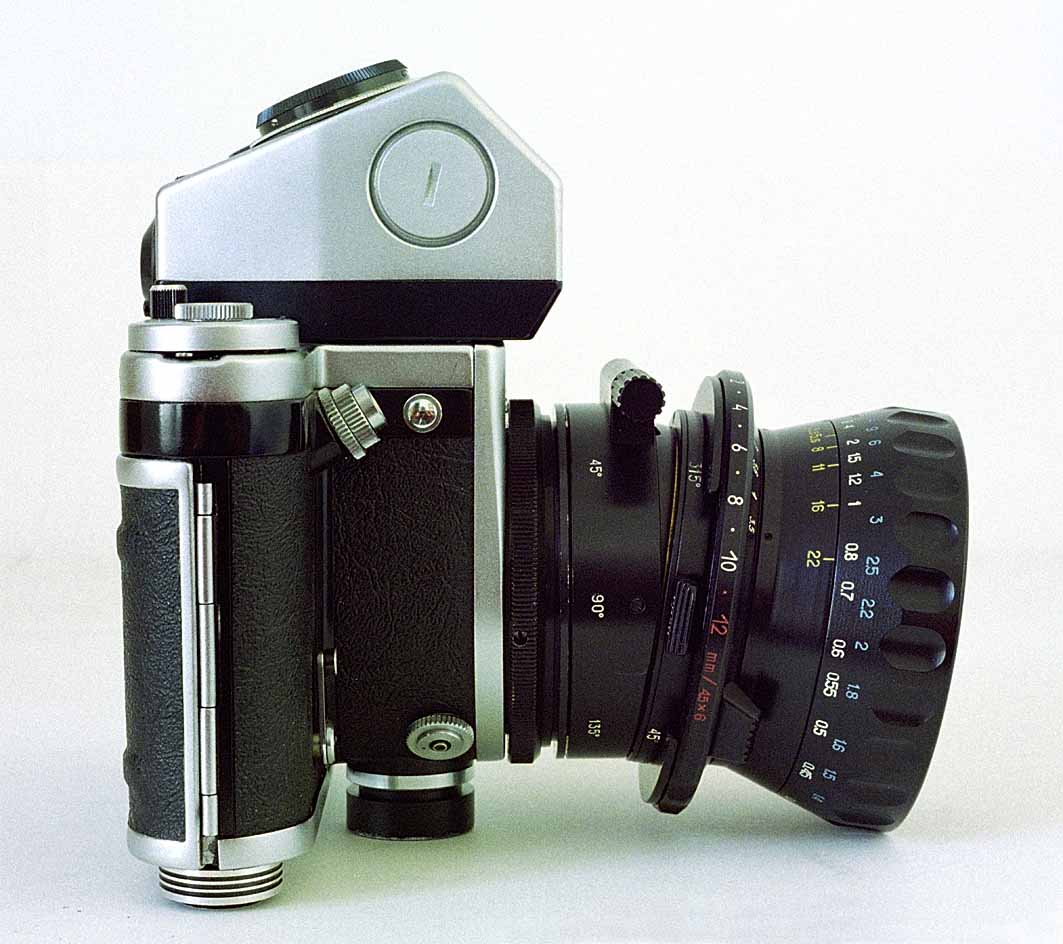 and fully tilted
and fully tilted
|
There appears to be another tilt/shift version of the 45mm Mir
lens, this one produced by Richard Wiese of Hamburg, Germany, with
the name “Technoplan”. You can visit the Wiese-Fototechnik
website here.
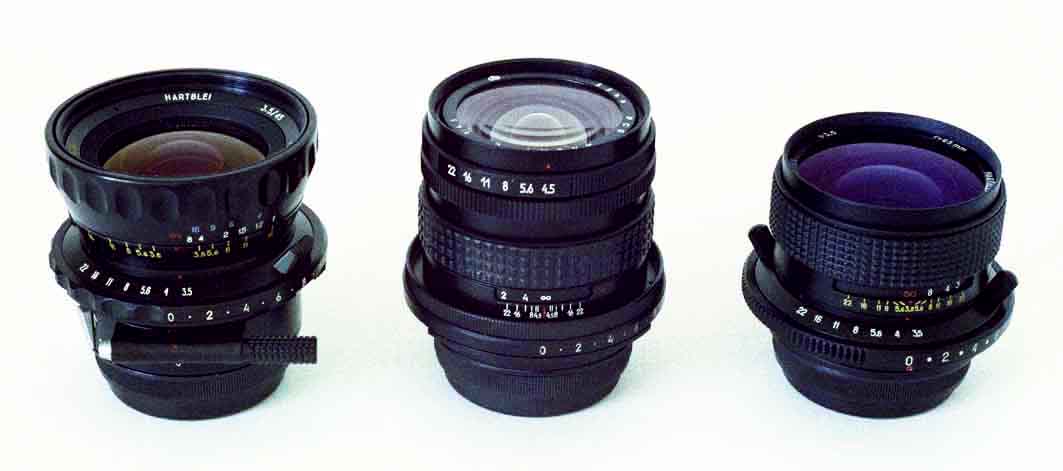
[C386-6A: 45mm Super-Rotator, 55mm Arsat shift and 65mm Hartblei
shift lenses
together in one photo, so that their relative sizes can be
compared.]
General requirement
of tilt lenses
Tilt lenses are
most frequently used in product photography, and
when we look at products of any sort (for instance, a meal on a
plate, a toy, a hand tool, etc.) we mostly look down
onto them. It is therefore desirable that any tilt lens
should tilt down.
As stated with regard to shift (only) lenses, it is of course
possible with a square-format camera to use it on its side, or
even conceivably upside-down, although using the Pentacon Six
upside down is difficult, or well-nigh impossible if the camera is
on a tripod -- and most product shots are taken with the camera on
a tripod. (I am of course aware that there are some tripods
that can mount the camera upside-down at the bottom of the centre
column, but this is not particularly convenient for most product
shots.) You can see the set-up for a product shot with a
tilt lens here. (It is in
fact the next page, so you can if you wish finish reading this
page and then click on the link at the bottom of the page to the
test of the Super-Rotator.)
However, a big plus of the Hartblei 45mm Super-Rotator is that it
has two, independent, rotation mechanisms:
- one enables the user to shift the lens in any
direction;
- the other enables the user to tilt the lens in
any direction (regardless of the direction of the shift).
In my opinion, if one is only buying one tilt lens, the
extra flexibility offered by the Hartblei Super-Rotator is
worth paying the extra for, if one can afford it (and if one
can find the lens, as – in 2016 – it appears no longer to be
in production).
Additional advantage of tilt
lenses
As a consequence of using the tilt facility, it is in many
situations not necessary to stop down to tiny apertures in
order to get adequate depth of field (the area within which
the different parts of the image are rendered sharply in
focus). This in turn means that faster shutter speeds can be
used – using a slow film that requires an exposure of 1 second at
f/22 is not much good if you're photographing a field of swaying
corn – or even a building with people walking past.
Of course, product photography
mostly involves work close up, and when any lens is focussed on
objects that are very near to the camera, the depth of field is
reduced dramatically. On such occasions, it is frequently
desirable to stop down the lens aperture somewhat or even
substantially, in order to increase the depth of field.
Experience will reveal the best apertures for different types of
tilt photography.
The Super-Rotator
tilted in use
For the non-shifted performance of the 45mm Mir 26 lens, I would
refer you to the Wide-Angle lens
tests section. Of course, even apart from the shift and tilt
capabilities, there are some major differences.
- Firstly, at least with the Hartblei lenses, a superior
multi-coating is applied.
- Secondly, mount design is far superior to that of many
Arsenal lenses, and the Hartblei 45mm has so far proved more
reliable and sturdy than the Mir 38 65mm Arsenal lens.
As reported on the page on shift lenses,
the expected barrel distortion did not prove obvious with this
lens in most real-life situations.
For a report on results obtained with this lens, click here.
| Mount
incompatibilities
When trying to mount the 45mm Hartblei Super-Rotator
and the 65mm Hartblei shift lenses on my 35mm SLR via
the standard East German Pentacon/Praktica adapter, I
discovered that it was impossible to lock the adapter
onto the lens, as the locking ring wouldn’t
rotate. (Come to think of it, rotating the locking
ring on the Exakta 66 had been difficult!) This
was because the three lugs against which the locking
ring mates were fractionally too thick!! Grinding
them down a little resolved the problem.
There were no such problems with the 55mm Arsat shift
lens.
Restrictions
on movements when a shift or tilt lens is used
on an Exakta 66 with the Exakta 66 TTL
metering prism
There are some restrictions on some movements with
shift and tilt lenses when mounted on an Exakta 66 with
the Exakta 66 TTL metering prism in place, as this
extends quite a way forward of the original front plate
of the camera. None of these movement restrictions
occur with any of these shift lenses if the camera is
used with the standard Exakta 66 waist level finder or
the Exakta 66 non-metering prism.
The restrictions are as follows:
Hartblei 45mm
Super-Rotator
It is difficult to rotate the tilt control (but
there is no problem to change the degree of tilt) once
the lens is on the Exakta 66 if a metering prism is on
the camera, as the front of the prism fouls the tilt
lever. However, there are no restrictions on
shifting in any direction when the Super-Rotator is
mounted on the Exakta 66 with a metering prism, as the
shift mechanism is further forward with this lens than
with the other shift lenses. Also, if required,
the tilt ring can be rotated prior to mounting the lens
on the camera.
Arsat 55mm Shift lens
It is not possible to shift the 55mm Arsat lens very
far up when it is mounted on an Exakta 66 with the
metering prism, as the front of the prism limits
movement. However, as the default shift direction
is sideways (to the left as viewed from above), and as
the format is square, it is not a problem to rotate the
camera through 90 degrees, as we are accustomed to doing
with 35mm and other rectangular-format cameras, in order
to take the photograph.
Hartblei 65mm Shift lens
The maximum upwards shift is 4mm when the metering
prism is on the camera. Shift sideways or down is
unrestricted. Further, it is difficult to mount
this lens on the Exakta 66 with the metering prism
because a ring on the lens presses against the bottom of
the metering prism.
These problems are in fact caused by the
modification of the original Pentacon Six
specification by the designers of the Exakta 66.
It is for the same reason that it is not possible to
mount the Carl Zeiss Jena 1000mm mirror lens on the
Exakta 66 with metering prism.
|
For more information on Hartblei Shift and Shift/Tilt lenses, see
here.
To go back to the section on Other Accessories, click here.
To go on to the next section, click below.
Next section (Test of the Super-Rotator
Tilt-Shift lens)
To go back to the beginning of the Lens Data section, click below
and then choose the range of lenses that you want to read about.
Back to beginning of the Lens Data section
To go back to the beginning of the lens tests, click below and
then choose the focal length that you want to read about.
Back to beginning of lens tests
Home
© TRA December 2005 Latest revision: October 2019






